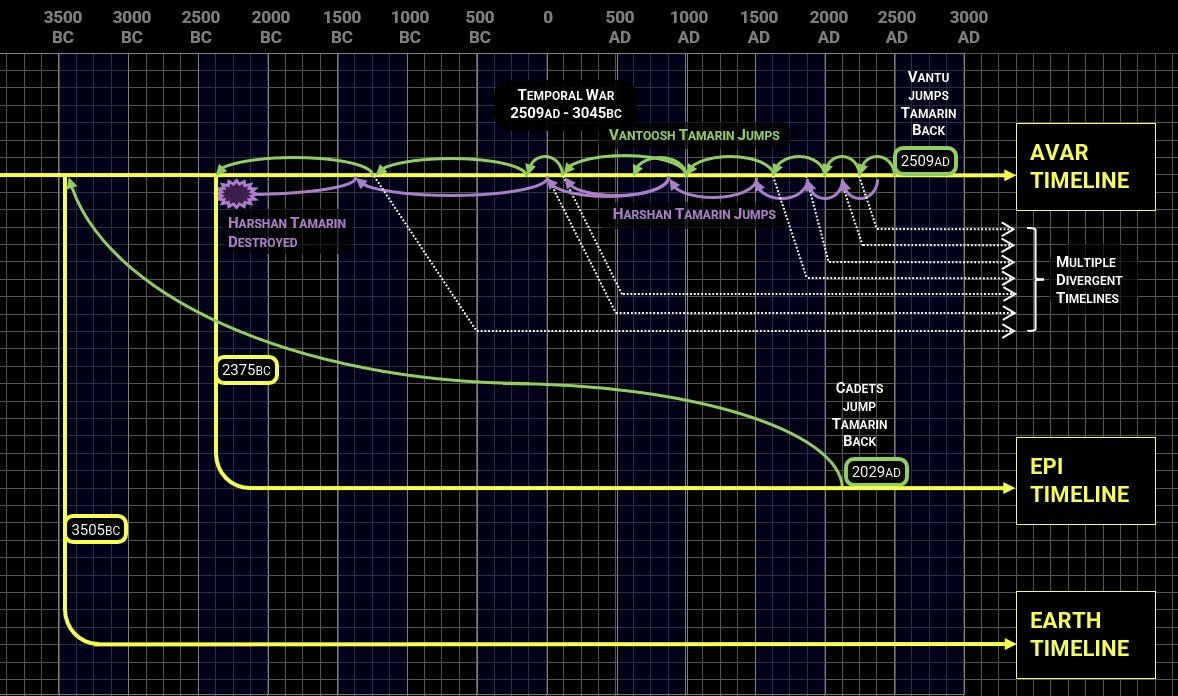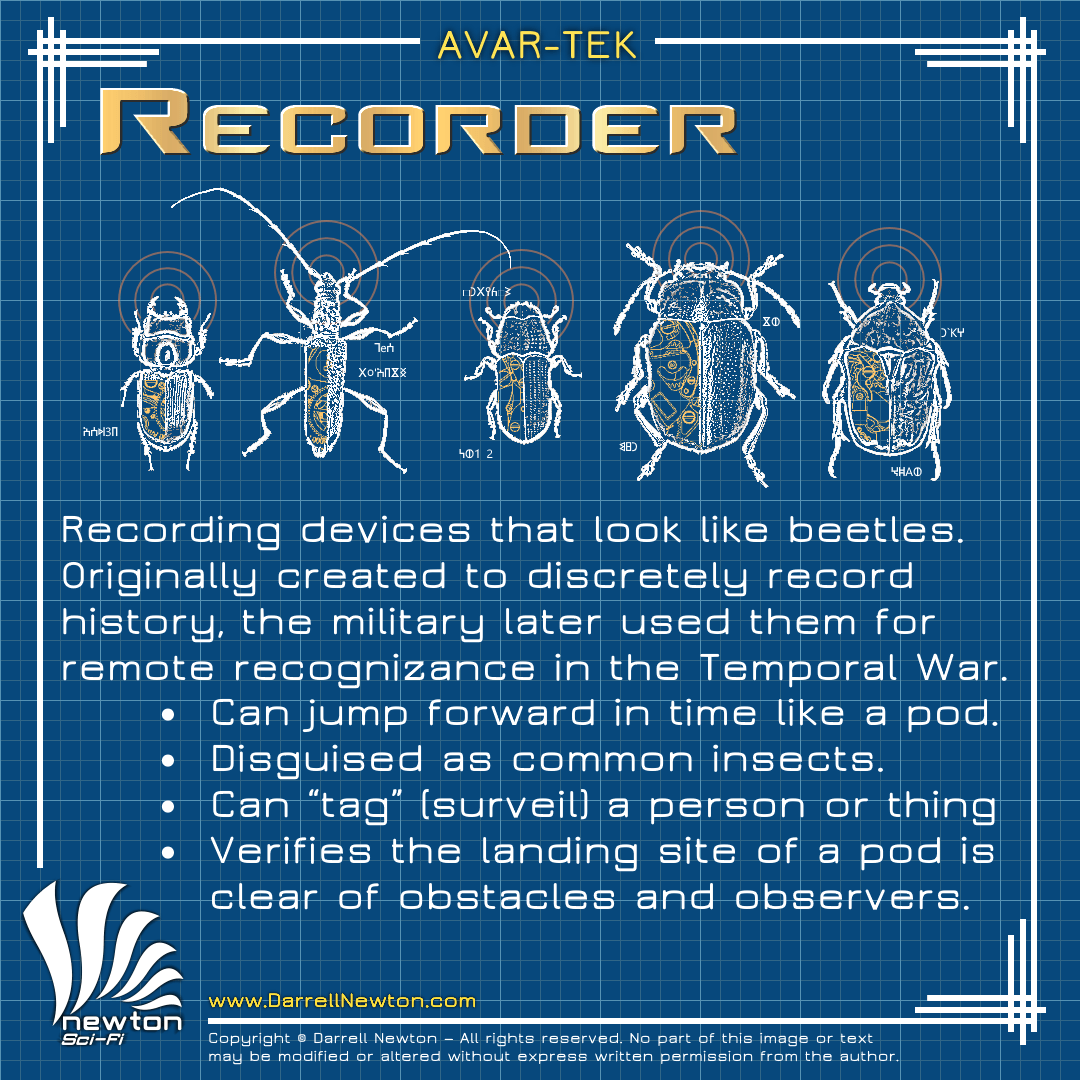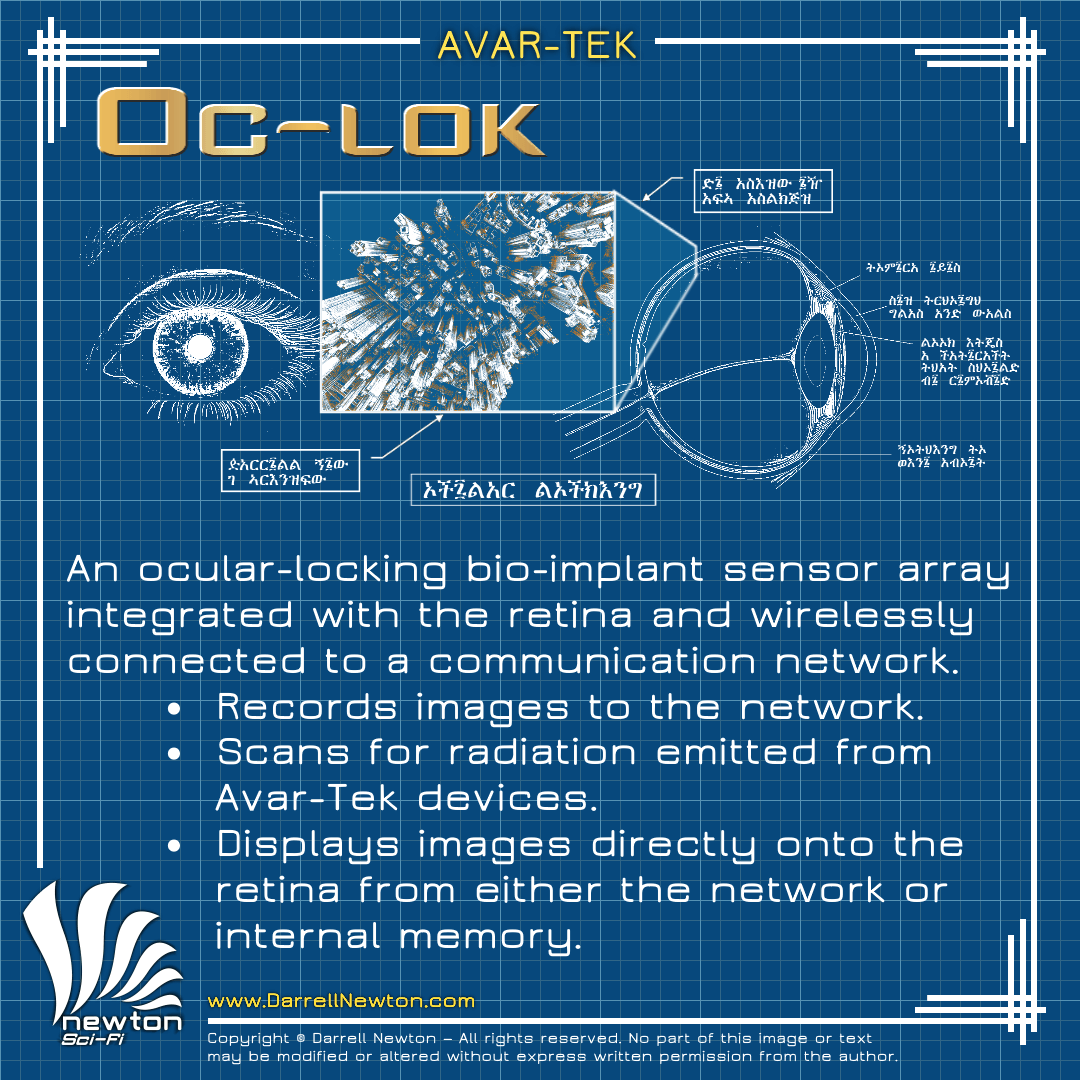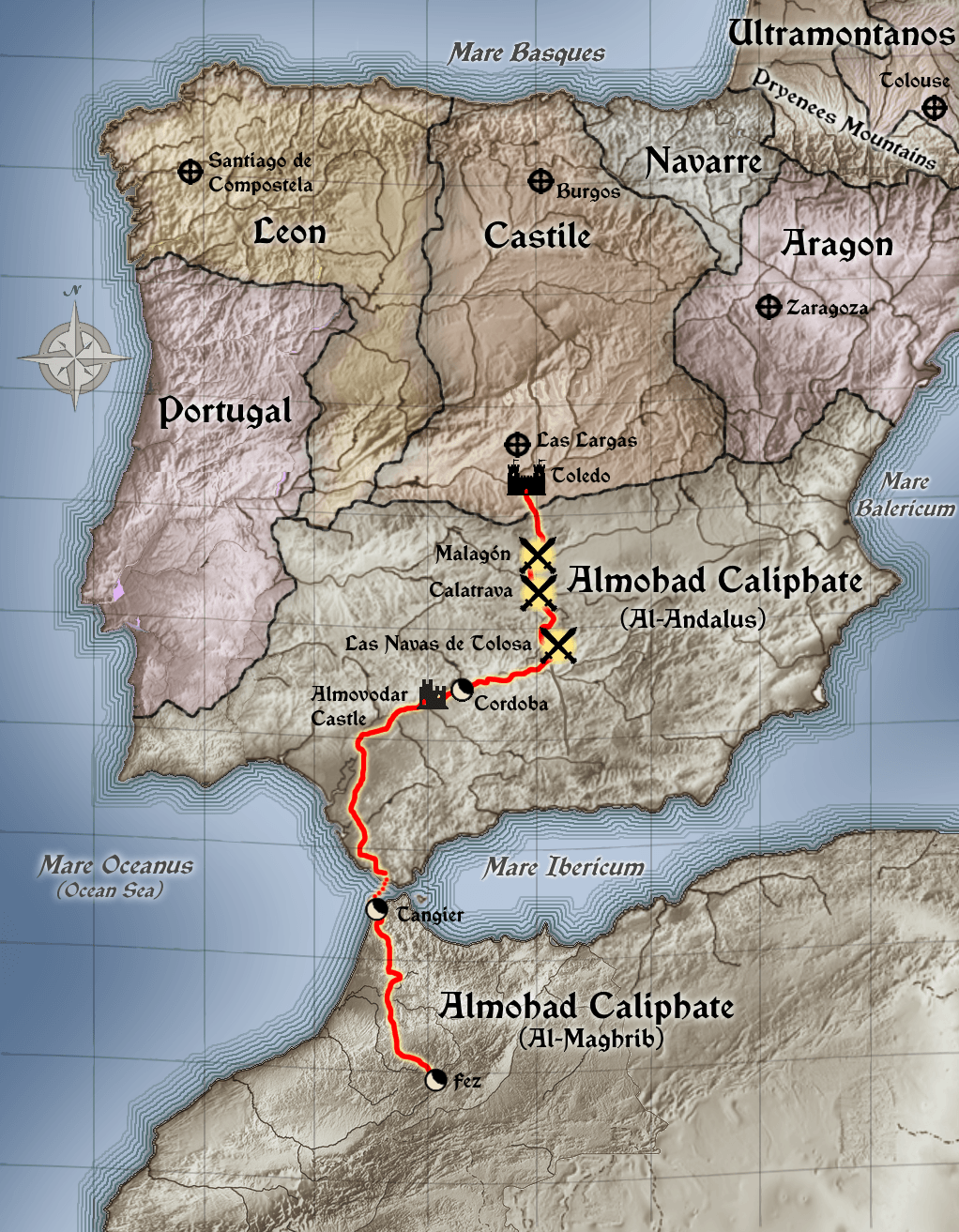Welcome to the
Avar Wiki
The place for Shadows of Time maps, timelines, characters, tech, and more.
Timelines
One Planet - More than Three Worlds
"What started as a scientific curiosity,
turned into a historian's dream,
and became a tool too powerful to use."
~ Lord Kantarō Tōgō
Minister of Foreign Affairs
Avarian Empire

How it started ...
Avar: the first timeline
Avar history more closely follows Earth history than Epi does with the exception that Christianity spread into Africa instead of Europe. Over the centuries as cultural and political influence shift to west Africa, the Bantu languages mix with Ethiopian and create the Vantu language. West Africa becomes the dominant continent/culture in the modern era instead of Europe.
In the 24th century, reverse time travel is discovered. An orbital observation platform called the Tamarin is launched to probe the past by sending recorders throughout earth to record history. The Time War starts in the year 2509 during the final days of a global war when the losing nations desperately try to change history to avoid annihilation.

How it continued ...
Epi: the second timeline
The Epi Timeline diverged from the Avar Timeline at the tail end of the Time War in 2375 BC. Trapped in the past, the Avarians taught he stone age natives about science and manufacturing. Eventually, the natives of the Epi timeline created seven industrial societies, but changes came too quickly and destroyed moral traditions. The advanced Epi societies devolved into anarchy ruled by warlords.
Instead of pushing for technological acceleration, the Avarians chose to guide the Epian natives from the shadows. Over the centuries, tension between the Avarian factions spawned wars until a world-wide conflict in 2029 AD drove some to seize the Tamarin and all on board were flung back to the year 3505BC, causing the Earth timeline to diverge.

How it will end ...
Earth: the third timeline
Alone in the year 3505BC, the refugees from Epi were left with no way to return home. They could use the Tamarin to jump forward to their launch date in 2029 AD, but they had already interacted with the past and changed history. Their home—their nation, culture, and language—was gone. In theory, their home existed, but they could not reach it.
Faced with living in the stone age with 26th century technology and knowledge, the Tamarin crew split into factions. The Key’ari wanted to use the technology to live as gods, either to be worshiped or to use their gifts to forge a better world. The Sittiri feared any more disturbance to the timeline would rip space-time. They wanted to nudge history from the shadows to reduce temporal tension.
The factions divided the world into regions of influence. The Key’ari clans each tried to raise a utopia built on their knowledge of two histories. The Sittiri chose a longer path based on limited interference, education through an academy, and a dedication to mend temporal rifts. Although their numbers were fewer, the Sittiri took most of the high tech known as Avar-Tek. To prevent more damage to the timeline, the Sittiri destroyed the Tamarin, the only vessel that can go back in time.
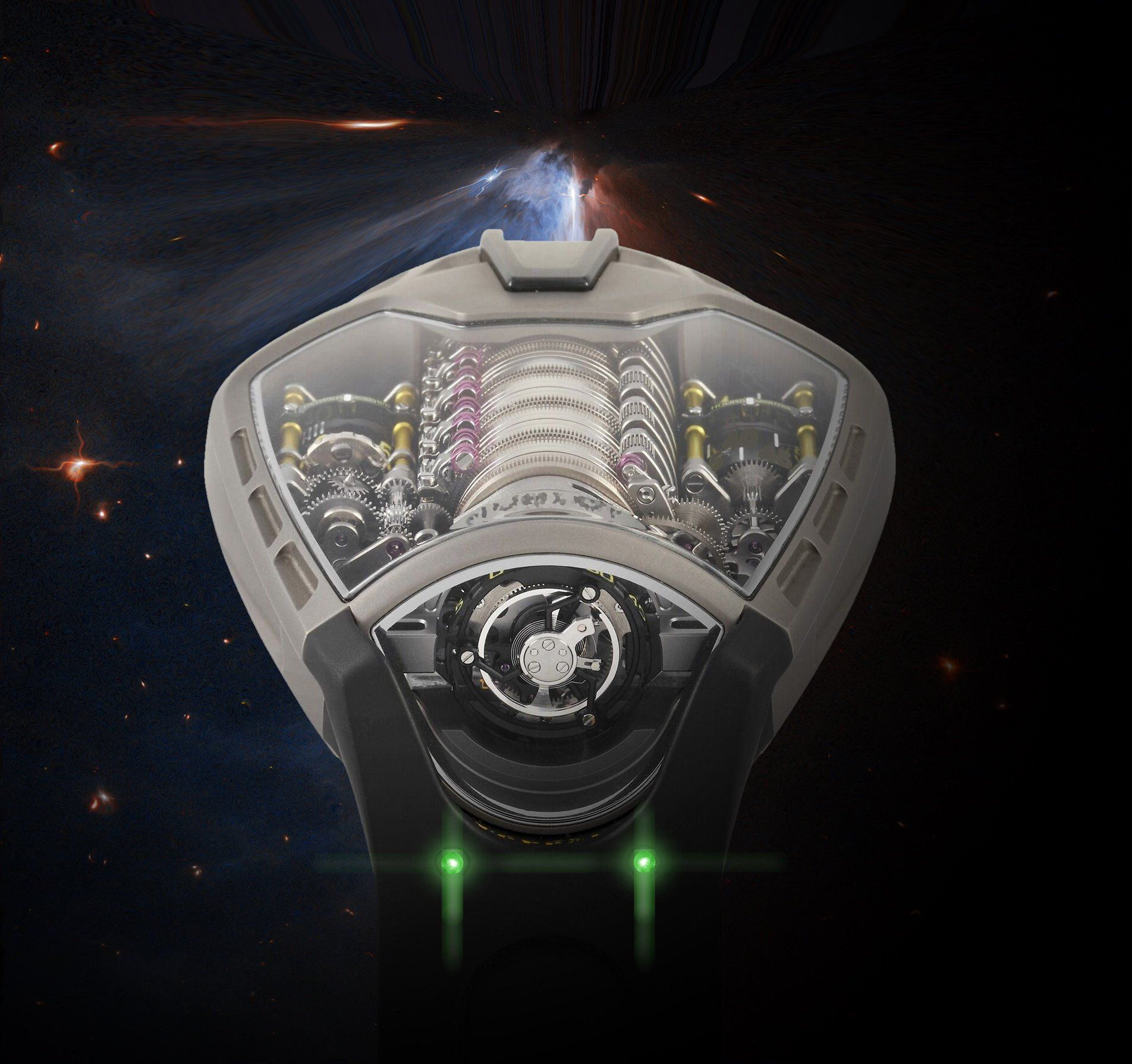
How do we get alternate timelines?
An alternate history (or divergent timeline) is created when someone or something goes back in time. This happens constantly but we don't see it because it's on the quantum level. We call timeline branching a "rift." When a rift occurs,
1. It creates two copies of the universe:
a. one in which the time traveler changed the past
b. one in which the time traveler did not.
2. A type of vacuum energy called temporal tension is created. If the rift is small enough--such as during quantum fluctuations--the temporal tension is low, and the timelines tend to pull back together and weave into one. This is called temporal superposition.
Some scientists theorize that if the overall temporal tension in a region is high enough, the fabric of spacetime will rip and destroy the universe. This final ripping has been named the "impasuko," which means “the ripping” in the ancient Avarian language of Vantu.
In the Shadows of Time series, only the Tamarin space-time ship can travel back in time. Accelerated forward time travel is possible with temporal pods but they cannot travel backwards.
Characters

Francisco de Toledo
Sex: Male
Age: 16
Born: January 2, 1196 AD-Earth Timeline
Religion: Christian
Origin: Kingdom of Castile (Spain)
Occupation: Street Urchin, Swordsmith’s Apprentice, Militiaman
Avar Allegiance: None
Avar-Tek:
Fieldstone (1)
Bio-Implants:
None
With his exceptional strength and dexterity, Francisco has great skill with the blade, but he is a peace-loving diplomat at heart. He will use violence as a last resort, but when he does, he is fearless. He acquired Avar healing stone at an early age and because he believed violence would rob its power, he avoided conflict, finding other methods to deal with adversity.
His appealing charisma attracts people as friends, and he builds them into teams. He discovers hidden skills and motivations in his friends and draws them into a group that balances their weaknesses with others’ strengths. This extends into his Latin-style courtship of women, making him a romantic. He loves troubadour music and tales of El Cid.

Sancho de Badajoz, AKA Moshe ben Shushan
Sex: Male
Age: 16
Born: February 12, 1196 AD-Earth Timeline
Religion: Jewish
Origin: Kingdom of Castile (Spain)
Occupation: Street Urchin, Baker’s Apprentice, Militiaman
Avar Allegiance: None
Avar-Tek:
None
Bio-Implants:
None
Moshe ben Shushan was raised in Badajoz (Spain) to a Jewish family of ancient text translators. When the Almoravid Muslims invaded his hometown, they threatened some dhimmis (non-Muslims) with either death or conversion. His parents refused and were killed, but Sancho escaped.
Orphaned, Moshe ben Shushan fled to Toledo in the Christian Kingdom of Castile and changed his name to Sancho. There he met and befriended Francisco. He followed Francisco into battle and stayed by his side as a voice of conscience, but the fear of being exposed as a traitor to his people gnawed at his conscious. He kept his origins secret from everyone except Francisco.
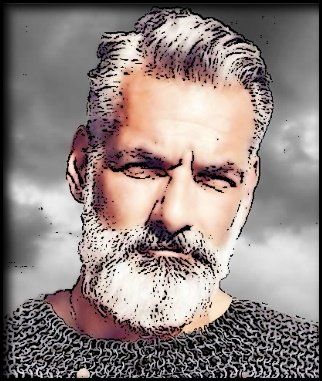
Commander Anglo-Sekūris, AKA the First Firesmyth
Sex: Male
Age: 92 (appears 52)
Born: June 6, 3202 BC-Earth Timeline
Religion: Christian (formerly Animism)
Origin: Par-yobros Tribe (Celtic Iberia)
Occupation: Recruiter, Department of Temporal Corrections
Avar Allegiance: Sittiri, Rank: Commander
Avar-Tek:
Verisuit
Fieldstone (2)
Stun-stick
Pod (shared with Miyuki)
Bio-Implants:
Froneesis (Heightened Intellect) and
Gravitas (Gravity Control)
Sittiri basic bio-implants
Angelo is the first Earth-timeline Sittiri recruit and the one true Firesmyth, having been the only member of the Par-yobros Tribe to be recruited by either the Key’aris or the Sittiri.
Over the millennia, Angelo has become a revered senior recruiter, having recruited over 90 Sittiri. He is a former Academe professor, and although he has essentially written the book on recruiting and contributed to many of the Sittiri laws, he has a roguish streak. Most of the younger generation hold him in high esteem, even to the point of veneration, but a large minority of the original Sittiri from Avar and Epi view Angelo with suspicion since he was originally recruited by the Key’ari. This suspicion has prevented him from advancing in the Sittiri ranks and becoming an Archon. Angelo does not hold this against the bureaucracy (neither in private nor in public) since he prefers working in the field with the younger generations.

Trainee Miyuki Yoshinaka 義仲
Sex: Female
Age: 24 (appears 24)
Born: April 30, 1162 AD-Earth Timeline
Religion: Christian (formerly Shintoism)
Origin: Nihon (Japan)
Occupation: Recruiter, Department of Temporal Corrections
Avar Allegiance: Sittiri, Rank: Trainee
Avar-Tek:
Verisuit
Fieldstone (2)
Stun-stick
Pod (shared with Angelo)
Bio-Implants:
Kinesis (Speed and Agility)
Sittiri basic bio-implants
Miyuki was a female Samurai (an onna-bugeisha) who at the age of 23 was recruited by Angelo in 1185 AD. She was graduated from the Sittiri Academe with high marks with the class of 1206 at age 24 and took her first assignment with Angelo as a trainee recruiter. She and Angelo are tasked with recruiting the famed One of Six.
In addition to being an accomplished archer, horse rider, and swordsman, she is a quick study, extremely loyal, and polite to a fault. At times, she carries perfectionism to an extreme, holding to ridged legalism and traditions. This leads her to be inflexible and self-condemning.
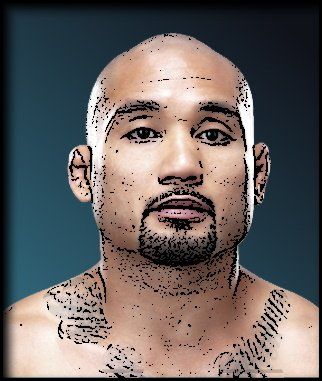
Commander Eden
Sex: Male
Age: 110 (appears 35)
Born: October 5, 395 AD-Earth Timeline
Religion: Shamanism
Origin: Hun, Ancient Sarmatia (modern Romania)
Occupation: Region 8 (West Europe) Director
Avar Allegiance: Key’ari, Rank: Commander
Avar-Tek:
Verisuit
Fieldstone (varies, he collects them)
Pod
Bio-Implants:
Froneesis (Heightened Intellect) and
Toxeesis (Poison/Pheromone/Viral)
Onyo (keeps this secret)
plus Key’ari basic bio-implants
The Key’ari recruited Eden with five others out of Attila’s army in 450 AD. The bow was his weapon of choice and when on horseback, few could rival him. He has an odd penchant for picking flowers, the more unusual, the better. He would stop, mid-assignment, dismount, walk off the road, pick a wildflower he hadn’t seen before, and slide it into the brim of his helmet. If he killed someone, he would kiss the flower and leave on the corpse’ chest.
Under his commander’s guidance, Eden used his Froneesis (heightened intellect) implant to build an Avarian level 3 bio-implant lab and recreate a long-forgotten bio-implant: Toxeesis. He hired the Physician to implant the toxeesis module into him. Eden used it to overthrow his commander.
He uses continues to expand his abilities with toxeesis beyond the use described in legend. He uses his froneesis insight into psychology and pheromones from his toxeesis to manipulate people. Those he can’t manipulate he poisons or infects with disease with a simple touch. Over the centuries, Eden rose in ranks until he acquired the governorship over Key’ari Region 8, which includes the Almohad and Spanish domains and all of southern Europe. He hopes to manipulate others to bring about his vision of a Key’ari utopia through a spiritual philosophy he calls the “Golden Path.”
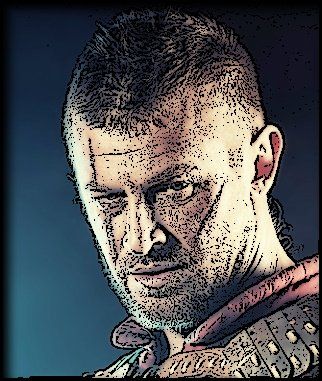
Chieftain Ceolwulf Iron-Blood
Sex: Male
Age: 30 (appears 25)
Born: April 30, 584 AD-Earth Timeline
Religion: Agnostic (Fledgling Anglo-Saxon Paganism)
Origin: Anglo Saxon (Mercia)
Occupation: Field Agent
Avar Allegiance: Key’ari, Rank: Chieftain
Avar-Tek:
Fieldstone (1)
Poison stone (1)
Poison stone programmer
Stun-stick
Pod (shared with his 3 teammates)
Bio-Implants:
Barutis (Strength)
plus Key’ari basic bio-implants
Born and raised in Mercia, Anglo-Saxon England, Ceolwulf used his strength and skill at arms to secure respectable wealth and reputation. He quickly became board with the fame and when Commander Angelo approached him, he eagerly joined the Sittiri as a recruit. With the Sittiri, he saw a way to rush in and grab the loot of Avar-Tek, and this left him vulnerable to the Key’ari’s temptation. Commander Eden turned him into a traitor, and Ceolwulf joined the Key’ari in 602 AD-Earth.
Gifted with his new Barutis (strength) bio-implants he quickly raised through the Key’ari ranks until a Viking named Erik ruined his reputation and replaced him. When Ceolwulf tried to return to friends in Mercia, Eden pod-jumped Ceolwulf six hundred years into the future when Mercia, the home Ceolwulf loved was no more. Resentful of both Eden and Erik, Ceolwulf is trapped in a future where reputation and the booty of war have lost all meaning.
Avar-Tek
Avarians

The Sittiri fix history from the shadows to avoid an event that will kill us all.
The Sittiri fix history from the shadows to avoid an event that will kill us all
The name Sittiri comes from the Vantu word meaning Hidden Fortress.
The Sittiri are descendants of those who felt the need to clean up the destruction from time travel. “Rifts” are the most destructive. They were created when alternate timelines were spun off. The Sittiri fear that, if enough rifts are created, temporal tension will rip space-time apart. They call this final cataclysm the “impasuko,” which means “the ripping” in the ancient Avarian language of Vantu.
During the Great Fracture (3505 BC), the Sittiri took the best Avar Tek and the Tamarin to an unknown location. Legend states the Sittiri destroyed the Tamarin to ensure no one could create another major timeline again.
To the Sittiri, the Key’ari are the worst offenders, carelessly creating rifts and occasionally even making them on purpose. So, the Sittiri have dedicated their lives to reduce temporal tension by avoiding time paradoxes, mending rifts, and defeating the Key’ari. They have created a cohesive society based on the best technology available and Christian morals. They selectively recruit among the plebs of this timeline according to predictions made by their central computer, the Ox Shalay. The Sittiri focus on education through the Academy, a philosophy of stoicism and humility, and a life dedicated to keeping the world safe from the impasuko.

The Key’ari take advantage of superior technology and to forge a better future.
The name Key’ari comes from the Vantu word meaning God Clans.
The Key’ari are descendants of those who viewed being stranded in the stone age with 35th century technology as a gift. Some wanted nothing more than to become gods and burned out quickly, leaving only a fading legend. Others with longer vision realized they could create a utopia. Were they not even morally obligated to do so? They had the history of two complete timelines to draw upon: over six thousand years of historical blunders to avoid.
But what were the blunders and what created the golden ages? They couldn’t agree. Shortly after the Great Fracture (3505 BC), the Key’ari splintered into clans of differing philosophies and settled in 24 regions around the globe. They still agreed on one thing: Power is not to be feared but to be used as an agent of change for the better.
To the Key’ari, the Sittiri are the worst offenders, hording technology that could make the world a better place and blindly focused on avoiding a disaster no one could prove would ever come. What the Key’ari lack in technology, they make up in numbers. They swell their rank with people from the Earth timeline with the promise of Avar-Tek gifts and the promise of a utopia. They outnumber the Sittiri, and their ranks grow every century. Eventually one of the clans would rise above the others and bring a lasting golden age for all.
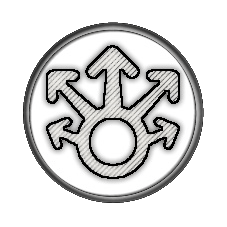
Small Avarian groups with various philosophies and methodologies
Groups that have split from the Sittiri or Key’ari over the millennia because of political, procedural, or philosophical reasons. None of them match the Key’ari or Sittiri in size or power and many have dwindled into obscurity.
A handful of factions broke away shortly after the landing in 3505 BC-Earth. From this initial splintering, only the Key’ari and Sittiri remain with any significance.
Throughout Earth’s history, rogues have occasionally banded together, but their cohesion was short-lived. Either the reason for their joining was temporary, or greed drove them apart, or another faction absorbed them into their ranks.

Lone Avarians with no allegiance to an Avarian group
Avarians who were a part of the Sittiri, Key’ari, or one of the Minor Factions, but who fled their group and hide among the plebs (the people of this timeline).
The rogues are hunted down by the other groups. The Sittiri want to keep rogues from creating rifts by exposing the plebs to advanced technology. The Minor Factions are eager to recruit rogues into their ranks. The Key’ari want the rogues’ Avar-Tek, even if they need to rip out their bio-implants. Rogues do not last long on their own.
Cultures & Politics
Cultures in The Healing Stone
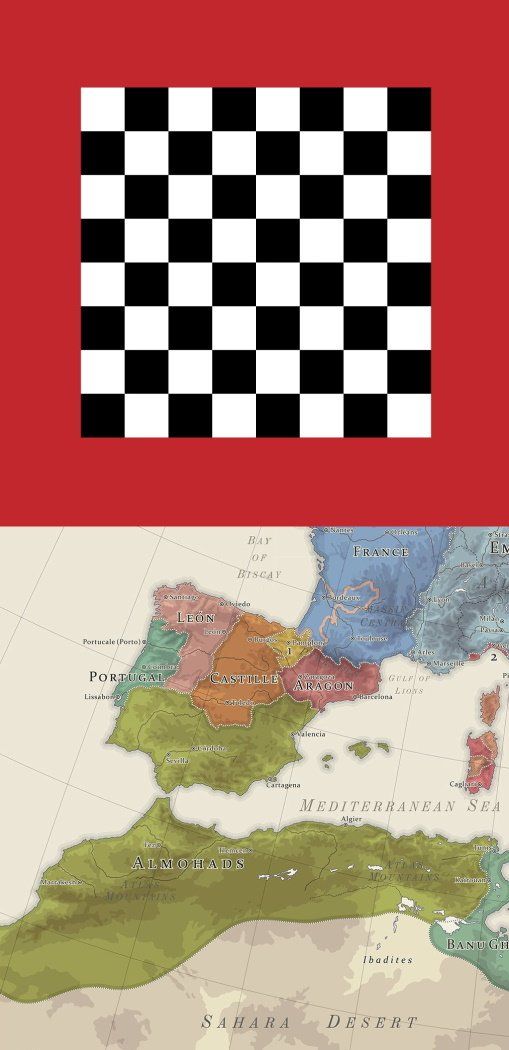
Those Who Advocate Tawhid
The Almohad Caliphate was a Moroccan Berber-Muslim dynasty founded in the 12th century. The Almohad reformation started in the Atlas Mountains about 1120 as a stricter form of Islam. They conquered most of northern Africa as far as Libya—the region known as Al-Maghrib. They swept north into Iberia (known as Al-Andalus) and conquered the fledgling Taifa states, independent Muslim principalities that competed among themselves for power and prestige. The Almohads viewed these states as having wandered from the faith.
Almohad fanaticism drove many Jewish and Christian subjects to take refuge in the growing Christian states of Portugal, Castile, Leon, and Aragon. The Almohads rejected the mainstream Islamic doctrine that established the status of dhimmi, a non-Muslim resident of a Muslim country who was allowed to practice his religion on condition of submission to Muslim rule and payment of the jizya (a yearly tax only non-Muslims pay). Although second-class citizens, Jews and Christians were allowed to practice their religion. This changed when the Almohads took over. After a seven-month grace period, the first Almohad leader Abd al-Mumin forced most of the urban dhimmi population in Morocco, both Jewish and Christian, to convert to Islam. Later, Jews who converted had to wear clothing that identified them as Jews since they were not regarded as sincere Muslims. Those who refused to convert were martyred.
The Almohad Califs governed Iberia and central North Africa from Morocco, treating them as provinces. When they ventured north into Iberia, it was with an army leading a jihad against the Christians and then return to Morocco. Ya'qub al-Mansur received his title "al-Manṣūr" ("the Victorious") because of his victory over King Alfonso VIII of Castile in the Battle of Alarcos (1195).
But in 1212, Yacub’s heir, Muhammad III "al-Nasir" (1199–1214), was defeated by an alliance of the four Christian princes of Castile, Aragón, Navarre, and Portugal, at the Battle of Las Navas de Tolosa in the Sierra Morena. The battle broke the back Almohad dominance.
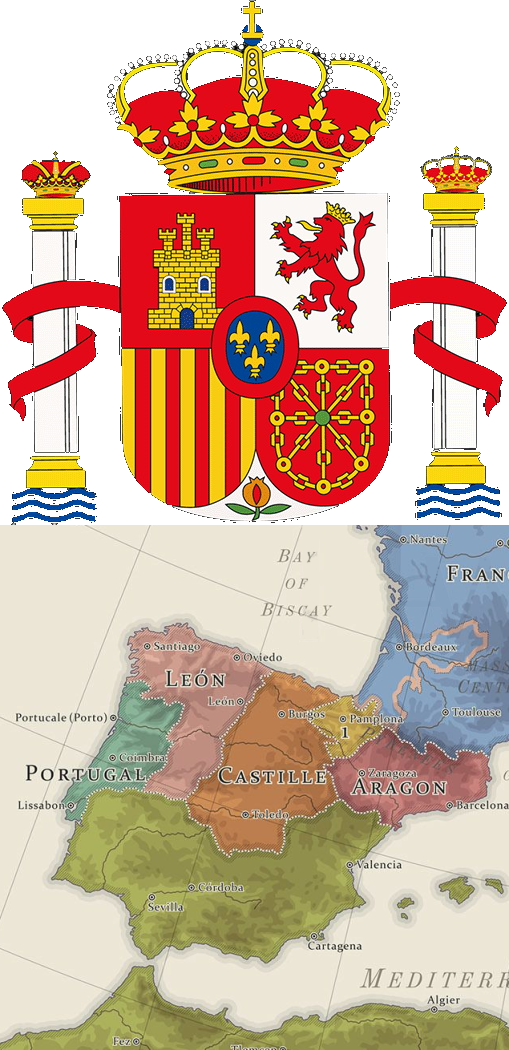
Kingdoms of Portugal, Leon, Castile, Navarre, and Aragon
In 1210AD, Spain did not exist. Several kingdoms laid claim to the Iberian Peninsula with the Muslim Almohad Caliphate in the south and the Christian Kingdoms of Portugal, Leon, Castile, Navarre, and Aragon in the north. The Christian kingdoms were rarely unified, at times squabbling with each other and aligning with Muslim principalities, and at other times unifying against the Muslims in the south. The Muslims also pressed northward to take land in a tug-of-war that had lasted centuries.
Living in Medieval Iberia meant living on the edge of war, but two events would have dominated the minds of those living in the Kingdom of Castile: El Cid and the Reconquista.
The Reconquista was the re-conquering of Iberia. It took 750 years for several Christian kingdoms to retake land lost during the Moorish invasion in 711AD.
Background: From 711 to 718AD, the Muslim Umayyad Caliphate in North Africa invaded and conquered most of the Iberian Peninsula, then controlled by the Visigoths. The invaders continued to push past the Pyrenees Mountains until the Franks stopped them at the Battle of Toulouse in 721 under Odo of Aquitaine and the Battle of Tours in 732 under Charles Martel.
By the 11th century, the Christian kingdoms were strong enough to retake some of the lost land. As these states battled the Muslims and, occasionally each other, Spain became a complex web of small kingdoms, including those set up by independent adventurers who took advantage of the political turmoil for their own ends. The most famous such figure was Rodrigo Diaz de Vivar, El Cid (c. 1043-1099AD), who eventually established his own short-lived kingdom based at Valencia.
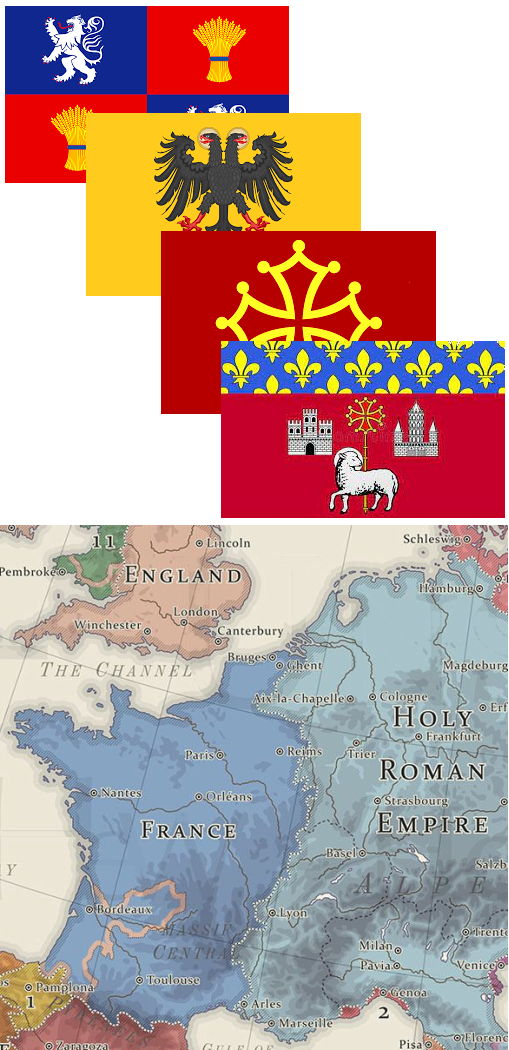
Those beyond the Mountains
ultramontano: (Spanish) adj. - a person or nation that is beyond or on the other side of the Pyrenees Mountains that separate the Spanish kingdoms from the Frankish kingdoms.
In the novel The Healing Stone, Francisco and Sancho joined a crusade in 1212 AD. The northern (Christian) combatants in the crusade were mostly Spanish, but others joined Pope Innocent III’s call to a crusade. Many of these came from over the mountains and included:
• French crusaders (northern France)
• Occitanian crusaders (southern France made up of Limousin, Auvergne, Languedoc, Provençal, Gascony, Toulouse, and other provinces)
• Crusaders from the Holy Roman Empire
• Other European crusaders
Many of the Ultramontanos viewed the lands south of the Pyrenees as a wild frontier filled with pagan-Muslims and semi-Christian barbarians who fraternized with the enemy.
The Utramontanos were all volunteers, responding to the appeal for aid and to the associated spiritual benefits. They signed up for a forty-day term of service that would grant them indulgences. This forty-day time limit was an effective incentive for recruiting soldiers, a method that started during the Albigensian Crusade two years earlier. But if the campaign lasted more than forty days, the soldiers would quit. This happened in The Healing Stone just before the Battle of Las Navas de Tolosa.
Maps
The Healing Stone Map
Francisco's Travels

